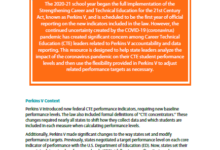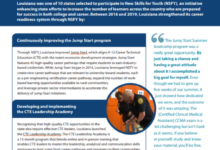In the summer of 2018, The Strengthening Career and Technical Education for the 21st Century Act (Perkins V) was reauthorized, continuing the investment in secondary and postsecondary Career Technical Education (CTE) programs across the nation. Last Fall, Advance CTE provided an analysis of all 50 states and Washington D.C.’s Perkins V plans, identifying common aspects that are indicative of a comprehensive and cohesive state plan, a number of which go beyond the law’s requirements and expectations to achieve a CTE without limits. This resource builds on the knowledge from Advance CTE’s review of state Perkins V plans to share promising practices and strategies for state CTE leaders to leverage when implementing their state plans in a way that promotes alignment across systems.
The enactment of Perkins V sought to reinforce cross-system alignment and collaboration, requiring coordination between secondary and postsecondary education, close alignment between education and the workforce development system and strengthened and expanded connections between Perkins V and other federal laws. This resource discusses the mechanisms in Perkins V for cross-system collaboration, an overview of how this appears in Perkins V state plans and an example of how a state is ensuring that engagement is ongoing and will successfully achieve a shared vision for education and workforce.






